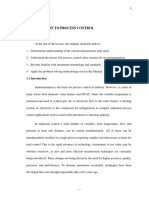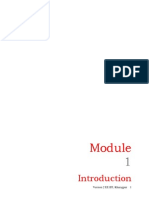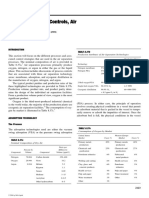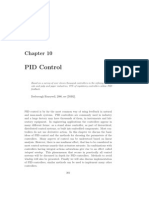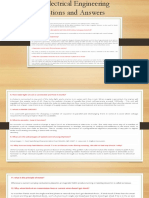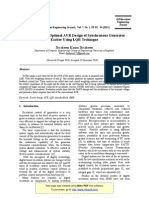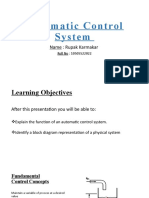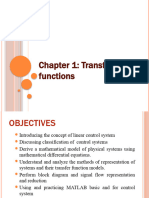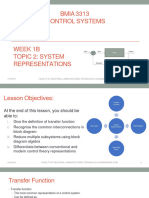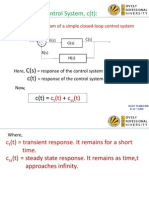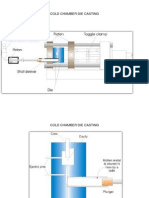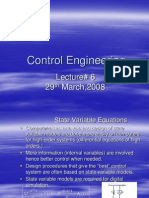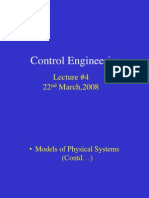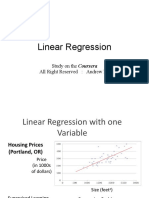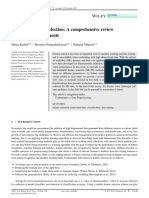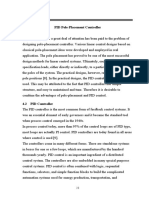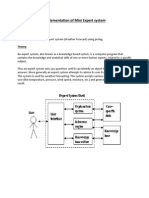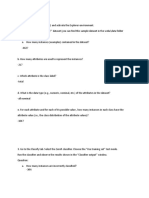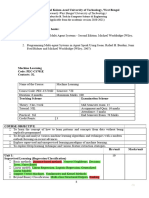Feedback Control Systems Engineering
Lesson 08: Closed-Loop Control System Part 2
Joshua Natividad
FEEDCON
29 June 2007
Page 1
�Objectives
After this lesson, the students will learn how to build closed-loop block systems (done) be able to simply and reduce closed-loop block systems using block system manipulation theorems (done) analyze systems with multiple inputs (principle of superposition), analyze real-world closed-loop systems, familiarize with controllers for closed-loop systems (PI, PID)
�References
R. S. Burns (2001), Advanced Control Engineering , USA: ButterworthHeinemann
�Block Diagram Manipulation
Review!
�Block Diagram Manipulation
Review!
�Block Diagram Manipulation
Review!
�Block Diagram Manipulation
Review!
�Principle of Superposition
The response y(t) of a linear system due to several inputs x1(t), x2(t), , xn(t), acting simultaneously is equal to the sum of the responses of each input acting alone.
�Example
????
Find the complete output for the system shown below.
�Solution
First, the block diagram is simplified
Cascade Feedback Loop
We need to work on simplified block diagrams!
�Solution
Simplified block
�Solution
Apply Principle of Superposition: put R2(s) = 0 and replace the summing point by +1 results to
What is the transfer function?
CI(s) --------------R1(s)
CI(s) is the response to R1(s) acting alone!
�Solution
The transfer function is therefore (with R1(s) acting alone)
or
�Solution
Next, put R1(s) = 0 and the summing point is replaced with -1, then the response CII(s) to input R2(s) acting alone is done by
Set to zero
Change to: -1
�Solution
The resulting diagram is shown below
First, we combine the three blocks that form a cascade, next we simplify the positive feedback loop.
�Solution
The resulting transfer function is
or
�Solution
Using the Principle of Superposition, we add CI(s) and CII(s)
or
Just add CI(s) and CII(s)!!!
�Problem Solving Approach
First, simplify the block diagrams using the block diagram reduction theorems. Second, apply principle of superposition if the system has multiple inputs.
Solve for the transfer function of the resulting diagram!
�Examples
Transfer functions of system elements:
DC Servo Motors Linear Hydraulic Actuators
�DC Servo Motor
�DC Servo Motor
The armature-controlled operation of the DC Servo Motor is shown in the block diagram
�DC Servo Motor
The behavior of the inputs with respect to the circuit is given by the equation
and taking the Laplace transform yields
�DC Servo Motor
Steady- State response
or
�DC Servo Motor
The behavior of a field controlled DC servo motor is given by the equation
�DC Servo Motor
From the model
we take the Laplace transform at zero initial conditions
�DC Servo Motor
Stead-state Conditions
�Controllers for Closed Loop Systems
The generalized closed-loop system
The control action u(t) will be such that the controlled output c(t) will be equal to the reference input r1(t) for all values of time, irrespective of the value of the disturbance input r2(t).
�Proportional Control
The control action, or signal, is proportional to the error e(t)
where K1 is the proportional gain constant
�Proportional Controller
For first order plants,
�Proportional Control
The transfer function of the plant is given by
which can be combined with the proportional control law
�Proportional Control
Re-arranging the equation yields
�Proportional Control
When r1(t) is a unit step, and r2(t) is set to zero, the final value theorem yields
When r2(t) is a unit step, and r1(t) is set to zero, the final value theorem yields
�Proportional Control Plus Integral (PI)
Consider the control law
Taking its Laplace transform yields
�Ti
The time interval in which the part of the control signal due to integral action increases by an amount equal to the part of the control signal due to proportional action when the error is unchanging.
�PI Control
The output of the system is
�BACKUP
Page 36

